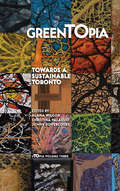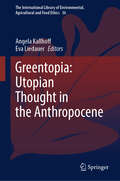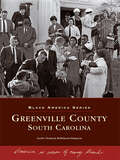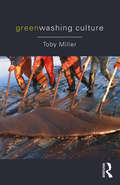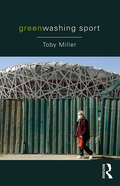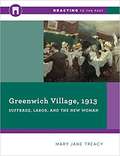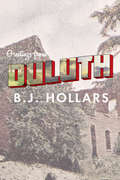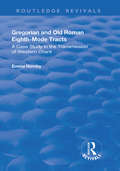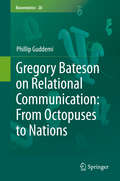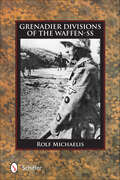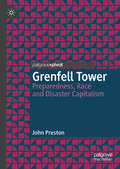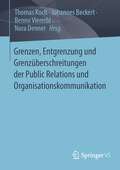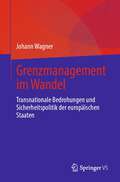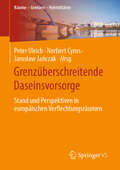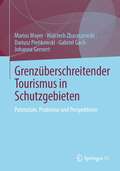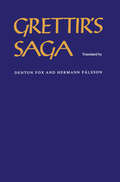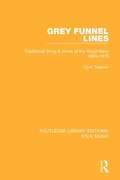- Table View
- List View
Greentopia: Towards a Sustainable Toronto (uTOpia)
by Jonny Dovercourt Alana WilcoxGardening the Gardiner. Hydrogen-fuelled cabs. Rooftop Power. Rainwater harvesting. A new model of taxation. The art of salvage. Drinking less coffee. Composters for dog poo in city parks. Ravine City.What would make Toronto a greener place?This third book in the uTOpia series asked imaginative Torontonians to think both big and small about how we might make our city more environmentally wise and responsible. They responded with immodest proposals and how-to tips, thoughtful considerations and flights of fancy that just might work. They wrote essays long and short, taking stock of how far weve come in the struggle to green ourselves and providing suggestions for simple actions with big effects. Their ideas sometimes playful, sometimes pie-in-the-sky offer brazen new perspectives on transportation, garbage, trees, energy, water, animals and green space and arrive at imaginative and ingenious solutions to the problems plaguing all modern cities.GreenTOpia features a resources section, including profiles of key eco-friendly groups in the GTA, a directory of green organizations, as well as a how-to guide and a fun-facts section.
Greentopia: Utopian Thought in the Anthropocene (The International Library of Environmental, Agricultural and Food Ethics #36)
by Angela Kallhoff Eva LiedauerGreentopia: Utopian Thought in the Anthropocene provides new ways of imagining the future interface between society and non-human nature and brings into focus the possibility of a peaceful coexistence. “Greentopia” is a mode of thought that takes us beyond mourning environmental degradation and ecological catastrophe. The absence of already-paved paths in the area gives space for a variety of experiments in thinking. The book interprets its subject, “Greentopia”, as a method of re-imagination, yet also as a very concrete practice. It brings together researchers from different areas to investigate environmental utopia from their respective angles. The present volume is of highest interest for environmental ethicists, but also of interest for anyone involved in current discourses on utopianism, life in the Anthropocene, environmental crises, the future of agriculture and green cities.
Greenville County, South Carolina (Black America Series)
by Leola Clement Robinson-SimpsonCradled at the foothills of the beautiful Blue Ridge Mountains and once known as the "Textile Center of the South," Greenville has evolved into a prosperous hub for corporate development and global commerce. Greenville County's African American community, proud and resourceful, has strong roots dating back to 1770, when blacks helped to carve the county out of an upstate wilderness. The experiences of the black community and its long relationship with whites up to the civil rights movement helped to create the climate for the kaleidoscope of races and cultures in Greenville today.
Greenwashing Culture
by Toby MillerGreenwashing Culture examines the complicity of culture with our environmental crisis. Through its own carbon footprint, the promotion of image-friendly environmental credentials for celebrities, and the mutually beneficial engagement with big industry polluters, Toby Miller argues that culture has become an enabler of environmental criminals to win over local, national, and international communities. Topics include: the environmental liabilities involved in digital and print technologies used by cultural institutions and their consumers; Hollywood's 'green celebrities' and the immense ecological impact of their jet-setting lifestyles and filmmaking itself; high profile sponsorship deals between museums and oil and gas companies, such as BP's sponsorship of Tate Britain; radical environmental reform, via citizenship and public policy, illustrated by the actions of Greenpeace against Shell's sponsorship of Lego. This is a thought-provoking introduction to the harmful impact of greenwashing. It is essential reading for students of cultural studies and environmental studies, and those with an interest in environmental activism.
Greenwashing Sport
by Toby MillerProfessional sports promote their green credentials and yet remain complicit in our global environmental crisis Sports are responsible for significant carbon footprints through stadium construction and energy use, player and spectator travel, and media coverage. The impact of sports on climate change is further compounded by sponsorship deals with the gas and petroleum industries—imbuing those extractive corporations with a positive image by embedding them within the everyday pleasure of sport. Toby Miller argues that such activities amount to "greenwashing". Scrutinizing motor racing, association football, and the Olympics, Miller weighs up their environmental policies, their rhetoric of conservation and sustainability, and their green credentials. The book concludes with the role of green citizenship and organic fan activism in promoting pro-environmental sports. This is a must-read for students and researchers in media, communications, sociology, cultural studies, and environmental studies.
Greenwich Village 1913: Suffrage, Labor, And The New Woman
by Mary Jane TreacyIn this Reacting to the Past game, the classroom is transformed into Greenwich Village in 1913, where rebellious “free spirits” gather. Exposed to ideas like woman suffrage, socialism, birth control, and anarchism, students experiment with forms of political participation and bohemian self-discovery. Reacting to the Past is an award-winning series of immersive role-playing games that actively engage students in their own learning. Students assume the roles of historical characters and practice critical thinking, primary source analysis, and argument, both written and spoken.
Greetings from Duluth: Essays on Destruction
by B. J. HollarsJoin B.J. Hollars as he takes readers on a whirlwind tour of destruction: from Fort Wayne's almost-obliteration at the hands of Adolf Hitler, to Tuscaloosa's 2011 tornado, and finally, to a triple lynching that occurred in Duluth in the summer of 1920. Spanning nearly a continent and a century, Hollars re-reports the details of these destructions, uncovering new facts and new perspectives in the swirl of what little remains. Relying on equal parts lyricism, experimental forms, and personal experience, Hollars' "Greetings From Duluth" explores our complicated relationship with the places we call home.
Gregorian and Old Roman Eighth-mode Tracts: A Case Study in the Transmission of Western Chant (Routledge Revivals)
by Emma HornbyThis title was first published in 2002: This text uses detailed analysis of the eigth-mode tracts in addressing some of the still unresolved questions of chant scholarship. The first question is that of the nature of the relationship between Old Roman and Gregorian chant, the second, of the relationship between oral and written modes of transmission in the ecclesiastical culture of the Middle Ages. Also, the Middle Ages saw a transition to a culture more dependent on writing. The book investigates the effect this transition had on the way eighth-mode tracts were understood by those who performed and notated them.
Gregory Bateson on Relational Communication: From Octopuses to Nations (Biosemiotics #20)
by Phillip GuddemiThis book develops Gregory Bateson’s ideas regarding “communication about relationship” in animals and human beings, and even nations. It bases itself on Bateson’s theory of relational communication, as he described it in the zoosemiotics of octopus, mammals, birds, and human beings. This theory includes, for example, the roles of metaphor, play, analog and digital communication, metacommunication, and Laws of Form. It is organized around a letter from Gregory Bateson to his fellow cybernetic thinker Warren McCulloch at the time of the Cuban Missile Crisis. In this letter Bateson argued that what we would today call zoosemiotics, including Bateson’s own (previously unpublished) octopus research, should be made a basis for understanding the relationship between the two blocs of the Cold War. Accordingly the book shows how Bateson understood interactive processes in the biosemiotics of conflict and peacemaking, which are analyzed using examples from recent animal studies, from primate studies, and from cultural anthropology. The Missile Crisis itself is described in terms of Bateson’s critique of game theory which he felt should be modified by an understanding of the zoosemiotics of relational communication. The book also includes a previously unpublished piece by Gregory Bateson on wolf behavior and metaphor/ abduction.
Grenadier Divisions of the Waffen-SS
by Rolf MichaelisConcise history of all 18 Waffen-SS grenadier divisions in WWII
Grenfell Tower: Preparedness, Race and Disaster Capitalism
by John PrestonThe Grenfell Tower fire of June 2017 is one of the most tragic political events in British history. This book argues that preparedness for disasters has always been designed in the interests of the State and Capital rather than citizens. This was exemplified by the ‘stay put’ strategy at Grenfell Tower which has historically been used to socially control racialised working class groups in a disaster. ‘Stay put’, where fire safety is compromised along with strategic ambiguity, probabilistically eliminates these groups. Grenfell Tower is a purposive part of ‘Disaster Capitalism’, an asocial racial and class eliminationism, where populations have become unvalorisable and disposable. We have reached a point where even the ruling class are fleeing from the disasters and chaos they have inflicted on the world, retreating to their billionaire bunkers. This timely book will be of interest to sociologists, social theorists and activists in understanding the racialised, classed and capitalist nature of contemporary disasters.
Grenzen, Entgrenzung und Grenzüberschreitungen der Public Relations und Organisationskommunikation
by Thomas Koch Johannes Beckert Benno Viererbl Nora DennerDer insbesondere durch die Digitalisierung ausgelöste Medienwandel und die daraus erwachsenen Veränderungsprozesse für die Public Relations und Organisationskommunikation führ(t)en zum Verschwimmen zahlreicher Grenzen, die früher deutlicher zu erkennen waren. Der vorliegende Sammelband nimmt in drei Themenblöcken diese Grenzverschiebungen und die daraus resultierenden Veränderungsprozesse in den Blick. Erstens wird die Entgrenzung des Berufsfelds der PR und Organisationskommunikation betrachtet, wobei insbesondere die Vermischung von Journalismus und strategischer Kommunikation im Fokus steht. Zweitens fokussiert der Band die Entgrenzung spezifischer Bereiche und Instrumente der strategischen Kommunikation (z.B. Wahlkampfkommunikation, Markt- und Markenkommunikation, Beteiligungsverfahren). Drittens gehen Beiträge in dem Band Fragen nach ethisch-normativen Grenzverschiebungen und -überschreitungen in der strategischen Kommunikation nach und diskutieren, wie diese neu verhandelt werden.
Grenzmanagement im Wandel: Transnationale Bedrohungen und Sicherheitspolitik der europäischen Staaten
by Johann WagnerDieses Buch befasst sich mit den Prozessen des Wandels und der Erneuerung der Grenzkontrollen und der Grenzsicherung und -verwaltung in den letzten 30 Jahren nach dem Fall des Eisernen Vorhangs sowie mit den immensen Herausforderungen bei der Nationenbildung in Südosteuropa nach dem Zusammenbruch des ehemaligen Jugoslawien in Bezug auf das strategische Sicherheitsmanagement. Die Abschaffung der Grenzkontrollen im Schengen-Raum und die gleichzeitige Einführung notwendiger Ersatzmaßnahmen war ein weiteres Thema.Das Buch gibt einen Einblick in die Kompetenzen der Europäischen Union bei der Reform und Modernisierung der staatlichen Strafverfolgungsbehörden zur Gewährleistung einer effektiven Grenzkontrolle, Grenzüberwachung und Grenzverwaltung im Einklang mit dem EU-Besitzstand und den EU-Standards.Im 21. Jahrhundert schafft ein sich ständig weiterentwickelndes Sicherheitsumfeld zusammen mit dem Prozess der Globalisierung neue Dimensionen von Bedrohungen und Herausforderungen für die Sicherheit und Stabilität transnationaler Natur. Dies erfordert umfassende, multidimensionale, kollektive und gut koordinierte Antworten.Die Europäische Union, die Organisation für Sicherheit und Zusammenarbeit in Europa (OSZE), die Vereinten Nationen sowie andere internationale Organisationen sind in der Lage, einen echten Beitrag zur Entwicklung kooperativer und koordinierter Antworten auf diese Bedrohungen zu leisten, indem sie sich auf ihre breite Mitgliedschaft und ihr profundes Fachwissen und ihre Erfahrung stützen.Nach Auffassung der Europäischen Union sollte ein modernes, kosten- und nutzenorientiertes und effektives Grenzschutzsystem sowohl offene Grenzen als auch ein Höchstmaß an Sicherheit gewährleisten. Daher ist die Union bestrebt, die innere Sicherheit aller Mitgliedstaaten durch die Verhinderung grenzüberschreitender Bedrohungen, die Bekämpfung der irregulären Migration und jeglicher Form der grenzüberschreitenden Kriminalität zu gewährleisten, um einen reibungslosen Grenzübertritt für legitime Reisende und deren Hab und Gut, Waren und Dienstleistungen sicherzustellen.Aus diesem Grund wurde das Unionskonzept des integrierten Grenzschutzes entwickelt, um eine wirksame Grenzkontrolle und -überwachung sowie eine kosteneffiziente Verwaltung der Außengrenzen der Europäischen Union zu gewährleisten.Die Politik der Union wird auch in Zukunft auf der Grundlage der drei wichtigsten Bereiche entwickelt: gemeinsame Rechtsvorschriften, enge operative/taktische Zusammenarbeit und finanzielle Solidarität. Darüber hinaus wurde die integrierte Grenzverwaltung als vorrangiger Bereich für die Stärkung der Zusammenarbeit mit Drittländern im Rahmen des strategischen Sicherheitsmanagementkonzepts der Europäischen Kommission bestätigt, in dem Nicht-EU-Länder als Partner ermutigt werden, ihre Grenzsicherheits-, Überwachungs- und Grenzverwaltungssysteme zu verbessern.
Grenzüberschreitende Daseinsvorsorge: Stand und Perspektiven in europäischen Verflechtungsräumen (Räume – Grenzen – Hybriditäten)
by Peter Ulrich Norbert Cyrus Jarosław JańczakGrenzüberschreitende Verbindungen werden in der Europäischen Union dichter und intensiver. Die national organisierten und ausgerichteten Angebote der öffentlichen Daseinsvorsorge kommen an ihre Grenzen. Der Band führt in das innovative Konzept der grenzüberschreitenden Daseinsvorsorge ein und bietet eine theoretisch fundierte Grundlage für die Analyse von Stand und Entwicklungsperspektiven grenzüberschreitender Angebote der Daseinsvorsorge. Das Buch versammelt Beiträge mit konzeptionellen Überlegungen sowie empirischen Analysen der Praxis grenzüberschreitender Kooperationen in den Daseinsvorsorgebereichen Mobilität, Gesundheit, Bildung, Katastrophenschutz, Energiekooperation, Wärmeversorgung, Raumplanung und Grenzmobilitätsberatung. Die transdisziplinäre Ausrichtung des Bandes befördert den intra- und interregionalen Dialog zur Gestaltung grenzüberschreitender Daseinsvorsorge und bietet Impulse für Lern- und Transferprozesse in und zwischen europäischen Verflechtungsräumen.
Grenzüberschreitender Tourismus in Schutzgebieten: Potenziale, Fallstricke und Perspektiven
by Marius Mayer Wojciech Zbaraszewski Dariusz Pieńkowski Gabriel Gach Johanna GernertDieses Buch erörtert, wie der Tourismus zwischen Nachbarländern wie Polen und Deutschland trotz des Schengener Abkommens behindert wird. Am Beispiel von Schutzgebieten im Nordosten Deutschlands und im Nordwesten Polens wird das Phänomen der sozioökonomischen und kulturellen Barrieren für den grenzüberschreitenden Tourismus analysiert. Darüber hinaus werden die Ergebnisse einer repräsentativen Online-Befragung in beiden Ländern vorgestellt und sozioökonomische und geographische Forschungen zu Grenzgebieten, Naturtourismus in Schutzgebieten, nationalen Stereotypen und Vorurteilen diskutiert. Als eine der wenigen Marktstudien zum Schutzgebietstourismus ist sie für Wissenschaftler und Praktiker (Schutzgebietsmanager, Tourismusfachleute) gleichermaßen relevant und bietet ihnen Einblicke in die Auswirkungen auf die künftige Forschung und Tourismuspraxis.
Grettir's Saga
by Hermann Palsson Denton FoxProfound and intriguing, Grettir's Saga is the last of the great Icelandic sagas. It tells of the life and death of Grettir, a great rebel, individualist, and romantic hero viewed unromantically. Grettir spends his childhood violently defying authority: as a youth of sixteen he kills a man and is outlawed; all the rest of his life he devotes, with remarkable composure, to fighting more and more formidable enemies. He pits himself against bears, berserks, wraiths, trolls, and finally, it seems, the whole population of Iceland. Yet he is not a bloodthirsty killer, but only a man who is totally unwilling to compromise. As a result of his desire for freedom, he becomes increasingly isolated, although he wishes to live in society, and indeed can hardly bear solitude. Driven back and forth from Iceland to Norway, harried around Iceland, he continually flees subjection and confinement only to find a perilous freedom beset both by the external hazards of a new land and by the internal hazards of loneliness and pride. He escapes to freedom and finds destruction. He finally meets his death in his last refuge on the top of an unscalable island near the northern tip of Iceland.Grettir's Saga has several themes. One of them is the conflict between the Christian world and the survival of the pagan world, as sorcery or heroic pride; the other is the conflict between man's desire for individual freedom and the restrictive bond imposed by society.This translation is the first into English since 1914; it is based on a more accurate Icelandic text than the earlier translations, and, unlike them, is unexpurgated and in unarchaic English. The saga has an especial modern relevance - a recent translation into Czech reached the top of the best-seller list. The present volume includes genealogies, a study of the legal system, and a critical assessment of the work.
Grey Funnel Lines: Traditional Song & Verse of the Royal Navy 1900-1970 (Routledge Library Editions: Folk Music #9)
by Cyril TawneyOriginally published in 1987. In this book we find songs reflecting every aspect of life in the twentieth-century Royal Navy, both upper and lower deck: war, ship’s routine, aviation, submarines, the antics of dockyard personnel, not to mention the matelot’s shore-going adventures, both amorous and bibulous. The compiler was well-known as a folk-singer, though he began his career in the Royal Navy. Based on his personal collection of Navy songs, this book proves that the sailor’s muse did not desert him with the passing of the sailing ship. It also dispels the notion that the modern Jack Tar, when he produces any songs at all, confines himself to the pornographic. With the songs, Cyril Tawney interweaves a commentary on the Royal Navy setting, providing a backdrop to the sailor’s own words. This book is of enduring appeal to all who have served as well as to students of twentieth-century oral tradition.
Grey Sex: Heterosexuality and Everyday Domination
by Alexandra KoglGrey sex is saying “yes” but thinking “no.” It’s feeling invisible, like you’re not even in the room. It’s wondering afterwards, “is that really what I wanted?” or “did I just let that happen?” Many people have sexual experiences that fall into a grey area between assault and “normal” sex. Looking at heterosexuality and everyday domination, this book shows that, in doing so, we are neither simply victims nor failing to assert ourselves. We are caught in relations of gendered power that may be hard to name or that may, in a world filled with violence, not seem worth mentioning. Tempting as it is to blame individuals for grey sexual experiences, Kogl argues that we can’t make sense of the power at work if we remain stuck in self-blame or point the finger at perpetrators. The personal is still political: the most intimate activities are both shaped by and shapers of unjust sexual hierarchies. Grey Sex walks us through the shadowy places between good and bad sex. With compelling insight into power relations that shape ambiguous sexual experiences and our sense of freedom, it is a valuable read for people interested in sexual intimacy and relationships, gender-based violence, and inequality.
Grey Wolf-- Mustafa Kemal: An Intimate Study of a Dictator (Routledge Revivals)
by H.C. ArmstrongMustafa Kemal was known both as a vicious dictator and the iron-willed creator of modern Turkey however little was known about him and he was viewed as an enigma by many. Originally published in 1932, Armstrong delves into Kemal’s career and personal life in great detail showing how he moved between revolutionary, soldier and politician whilst also discussing his love of women, drinking and gambling to present a clear picture of the infamous ruler. This title will be of interest to students of History and Middle-Eastern Studies.
Greyboy: Finding Blackness in a White World
by Cole BrownAn honest and courageous examination of what it means to navigate the in-between Cole has heard it all before—token, bougie, oreo, Blackish—the things we call the kids like him. Black kids who grow up in white spaces, living at an intersection of race and class that many doubt exists. He needed to get far away from the preppy site of his upbringing before he could make sense of it all. Through a series of personal anecdotes and interviews with his peers, Cole transports us to his adolescence and explores what it&’s like to be young and in search of identity. He digs into the places where, in youth, a greyboy&’s difference is most acutely felt: parenting, police brutality, Trumpism, depression, and dating, to name a few. Greyboy: Finding Blackness in a White World asks an important question: What is Blackness? It also provides the answer: Much more than you thought, dammit.
Grid Planning in the Urban Design Practices of Senegal
by Liora Bigon Eric RossThis book is the first to trace the genealogy of an indigenous grid-pattern settlement design practice in Africa, and more specifically in Senegal. It does so by analyzing how the precolonial grid-plan design tradition of this country has become entangled with French colonial urban grid-planning, and with present-day, hybrid, planning cultures. By thus, it transcends the classic precolonial-colonial-postcolonial metahistorical divides.This properly illustrated book consists of five chapters, including an introductory chapter (historiography, theory and context) and a concluding chapter. The chapters’ text has both a chronological and thematic rationale, aimed at enhancing Islamic Studies by situating sub-Saharan Africa’s urbanism within mainstream research on the Muslim World; and at contributing directly to the wider project of de-Eurocentrizing urban planning history by developing a more inclusive, truly global, urban history.
Gridded Worlds: An Urban Anthology
by Liora Bigon Reuben Rose-RedwoodThis book is the first edited collection to bring together classic and contemporary writings on the urban grid in a single volume. The contributions showcased in this book examine the spatial histories of the grid from multiple perspectives in a variety of urban contexts. They explore the grid as both an indigenous urban form and a colonial imposition, a symbol of Confucian ideals and a spatial manifestation of the Protestant ethic, a replicable model for real estate speculation within capitalist societies and a spatial framework for the design of socialist cities. By examining the entangled histories of the grid, Gridded Worlds considers the variegated associations of gridded urban space with different political ideologies, economic systems, and cosmological orientations in comparative historical perspective. In doing so, this interdisciplinary anthology seeks to inspire new avenues of research on the past, present, and future of the gridded worlds of urban life. Gridded Worlds is primarily tailored to scholars working in the fields of urban history, world history, urban historical geography, architectural history, urban design, and the history of urban planning, and it will also be of interest to art historians, area studies scholars, and the urban studies community more generally.
Gridiron Capital: How American Football Became a Samoan Game
by Lisa UperesaSince the 1970s, a “Polynesian Pipeline” has brought football players from American Sāmoa to Hawaii and the mainland United States to play at the collegiate and professional levels. In Gridiron Capital Lisa Uperesa charts the cultural and social dynamics that have made football so central to Samoan communities. For Samoan athletes, football is not just an opportunity for upward mobility; it is a way to contribute to, support, and represent their family, village, and nation. Drawing on ethnographic fieldwork, archival research, and media analysis, Uperesa shows how the Samoan ascendancy in football is underpinned by the legacies of US empire and a set of imperial formations that mark Indigenous Pacific peoples as racialized subjects of US economic aid and development. Samoan players succeed by becoming entrepreneurs: building and commodifying their bodies and brands to enhance their football stock and market value. Uperesa offers insights into the social and physical costs of pursuing a football career, the structures that compel Pacific Islander youth toward athletic labor, and the possibilities for safeguarding their health and wellbeing in the future.Duke University Press Scholars of Color First Book Award recipient
Gridiron Gauntlet: The Story of the Men Who Integrated Pro Football, In Their Own Words
by Andy PiascikOne year before Jackie Robinson broke the color line in major league baseball in 1947, four black players joined the Cleveland Browns and Los Angeles Rams to become the first professional football players of African-American descent in the modern era. While blacks had played on professional teams in the early days of pro football, none had joined a team since 1934. In this book twelve players who began their careers from 1946 to 1955 not only reminisce about the violence they faced on and off the field, the segregated hotels and restaurants, and general hostility that comes with being a trailblazer, but also of white players and coaches who assisted and supported them at various stages of their lives. Among the oral histories presented here are those of such Hall of Famers Bill Willis, Joe Perry, and George Taliaferro.
Gridlock
by Pardis MahdaviMahdavi (anthropology, Pomona College) qualitatively explores how Euro-American discourses and policies (forged primarily in Washington D. C. ) about human trafficking and migration affect the lived experiences of migration, forced labor, and trafficking in the United Arab Emirates, arguing that many of the policies ostensibly designed to reduce abuse and rights violations have had precisely the opposite effect. Instead of approaching trafficking as a criminal matter, she suggests, one needs to see it as a matter of migration and labor gone awry and thus as a human rights matter. Annotation ©2011 Book News, Inc. , Portland, OR (booknews. com)
